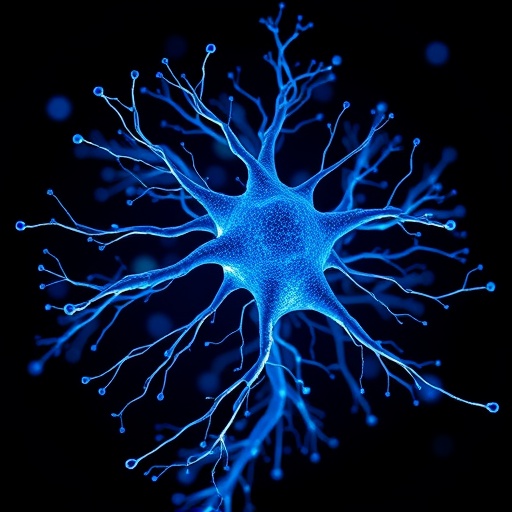
In recent groundbreaking research conducted by scientists at the University of Alabama at Birmingham (UAB) in collaboration with the University of Illinois Chicago, new insights have emerged into the fundamental mechanisms governing cellular differentiation within the olfactory system. This study sheds unprecedented light on how stem cells in living organisms govern their fate decisions amid the complex and noisy signaling environments inherent to vertebrate development. By integrating cutting-edge imaging with molecular profiling technologies, the team revealed a sophisticated signaling architecture that ensures continuous neurogenesis in the olfactory epithelium, an organ pivotal for the sense of smell.
The journey from a multipotent stem cell to a fully differentiated neuron involves a tightly regulated series of events. These include cell division to expand progenitor pools, fate determination where cells commit to a specific lineage, and cellular migration enabling integration into appropriate tissue structures. While previous in vitro studies had observed the tendency of stem cells to spontaneously organize into specialized cell clusters, the exact in vivo processes remained elusive due to the inherent complexity and stochasticity of signaling cues in densely packed tissues.
Focusing on the olfactory neuronal system, which is known for its remarkable regenerative capacity in vertebrates, the researchers utilized live zebrafish embryos to observe neurogenesis in real time with high-resolution microscopy. These embryos, transparent and genetically tractable, provided an ideal platform to trace individual progenitor cells and their progeny. The team combined this imaging with single-cell RNA sequencing, allowing them to correlate dynamic cellular behaviors with molecular signatures at unparalleled resolution, resulting in a comprehensive multi-dimensional dataset capturing the temporal progression of olfactory neurogenesis.
One of the most striking discoveries was the identification of a bistable toggle switch operating within progenitor cells. This molecular circuit functions as a decision-making node, orchestrating divergent cell fate outcomes that culminate in either the maintenance of progenitor status or differentiation into olfactory sensory neurons. This bistability enables discrete on/off states in gene expression despite the presence of fluctuating and noisy inputs, ensuring robustness in fate commitment. It acts as a filter to streamline the translation of stochastic signaling into reliable developmental outcomes.
Moreover, the study illuminated how progenitor cells assemble into transient “neighborhoods”—dynamic cellular clusters that act as functional niches within the olfactory epithelium. These neighborhoods facilitate intercellular communication that integrates signals locally and at the tissue scale, balancing proliferation with differentiation demand. This spatial organization is critical for sustaining steady neurogenesis, as it enables the olfactory system to replenish neurons continuously throughout the lifetime of the organism despite ongoing cell turnover.
The stochastic nature of signaling in developing tissues has long posed challenges to understanding how reproducible patterns of cell fate emerge during organogenesis. This research emphasizes how fluctuating molecular signals, initially appearing random, can be integrated through toggle switch circuits and neighborhood assemblies to achieve precise developmental control. Such insights refine our understanding of stem cell biology, particularly in complex, noisy in vivo environments that contrast with the more controlled conditions of cell culture.
Ankur Saxena, Ph.D., corresponding author and faculty member at UAB’s Department of Cell, Developmental and Integrative Biology, articulated the significance of these findings by underscoring the extraordinary regenerative turnover in the human olfactory system, where neurons are replaced roughly every two months. This constant renewal raised pivotal questions about the mechanisms that allow progenitor cells to consistently interpret variable signals and produce new neurons throughout life, maintaining sensory function amid cellular turnovers.
The implications of this research extend beyond olfaction, providing a template for understanding continuous neurogenesis in vertebrate systems with regenerative demands. By elucidating the molecular logic underlying progenitor fate decisions and niche formation, this study lays groundwork for exploring analogous pathways in other neural contexts and developmental stages. It offers a potential roadmap for harnessing stem cell biology in therapeutic contexts, particularly for neurodevelopmental disorders and neurodegenerative diseases in which regenerative processes are compromised.
Lead author Sriivatsan Govinda Rajan, Ph.D., now at Memorial Sloan Kettering Cancer Center, contributed significantly to uncovering how progenitor neighborhoods act as transient niches that temporally coordinate cellular processes essential for neurogenesis. Their work highlights the critical interdependence between single-cell molecular states and their spatial-temporal microenvironments, reflecting an emergent property of developmental systems that cannot be dissected purely at the molecular or cellular level alone.
The multidisciplinary approach combining live imaging, single-cell transcriptomics, and quantitative lineage tracking underscores the power of integrating technologies to resolve longstanding questions in developmental biology. The zebrafish model provided a uniquely accessible vertebrate system wherein cell behaviors can be observed in their native context, yielding data that are more representative of physiological conditions than in vitro models.
Looking ahead, the researchers aim to probe whether the molecular circuits revealed in this study have conserved functions across vertebrate species and in diverse neural tissues. Understanding how stem cells employ similar toggle mechanisms and neighborhood arrangements could revolutionize regenerative medicine strategies. Ultimately, translating these fundamental biological insights into clinical interventions holds hope for patients affected by conditions marked by neuron loss or dysfunction.
This study represents a significant advance in decoding the complex orchestration of continuous neural development. By revealing how stochastic signaling networks are harmonized through bistable molecular controls and transient niche formations, it offers a compelling paradigm for how robust organ regeneration is achieved amidst biological noise. Findings such as these expand our conceptual framework and open new horizons for advancing our capacity to manipulate and repair the nervous system.
Subject of Research: Animals
Article Title: Progenitor neighborhoods function as transient niches to sustain olfactory neurogenesis
News Publication Date: 3-Jul-2025
Web References:
Study Link on PubMed
Saxena Lab Website
References:
DOI: 10.1016/j.stemcr.2025.102575
Image Credits: UAB
Keywords: Developmental neuroscience, Neural stem cells, Larvae, Cellular neuroscience, Time lapse photography
Tags: cellular migration in tissue integrationcomplex signaling environments in developmentin vivo studies of neurogenesismolecular profiling technologies in neuroscienceneuron formation mechanismsolfactory system developmentregenerative capacity of olfactory neuronssignaling architecture in cell fatestem cell differentiation processesUAB University research collaborationvertebrate neurogenesis insightszebrafish model for neuronal research




